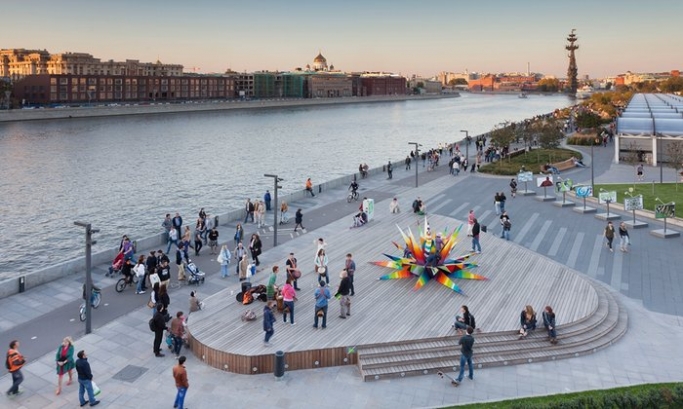“Things have started to improve”: Moscow residents share thoughts on the city’s changes

From cycling infrastructure to public spaces, how do Moscow’s residents feel about the city’s urban renewal projects? Here they share their stories.
The ‘Moscow experiment’ has seen the city undergo renewal efforts over the last five years to improve liveability. But what do Moscow’s residents really think about the changes? We asked you to share your stories of life in the Russian capital, and reflect on whether Moscow is changing for better or worse.
The city centre may be seeing improvements in infrastructure and public space, but what about the suburbs? How involved have local citizens been in the changes? And what does the future hold for Moscow? We’ve rounded up a selection of your GuardianWitness contributions, comments and emails, which reveal the everyday experiences of Moscow’s transformations:
Change in attitude changes people
As a born-and-raised Muscovite, I can say that this experiment succeded halfly, only because it has not finished yet. And it is not only about change in infrastructure which made Moscow a better place, it also brought a new generation of young people interested in the better future. For example from my own experience, I find more and more of my friends interested in programming and urban planning due to their visits to lectures provided by Gorky Park and Strelka. At the same time we see a rise in creativity in terms of services, such as “анти-кафе” ( anti-cafes) where you pay for time spent there rather than for coffee, hipster barbershops which are also popular among general population, affordable lunch places and so on. One of the most popular cafes “Циферблат” even opened one more cafe, not in Moscow but in Manchester, and it shows that there is a big change of service business, which became more oriented at people, rather than just their money.
About pedestrians and automobilists
Moscow has undergone massive change in the last five years, but the most obvious developments concern parks, streets, and general navigation in the capital. Most of the developments are surely positive: the city has seemed to get more air. There have appeared more walking paths, pedestrian zones have been expanded, some streets have been closed for traffic altogether, parks are being renovated, and new bicycle lanes are being offered now to city residents and its guests.
However, there are negative changes as well, which have largely affected car owners: extension of the paid parking areas, and the increase of the average price, the need to navigate a bypass route in order to drive round pedestrian zones. But this coin has another side too: fewer cars in the centre means less exhaust fumes and cleaner air.
Muscovites look forward to the old parks being renovated, and the new ones being opened. New plans make excited everyone: new metro stations, new roads, new bicycle lanes and pedestrian footpaths.
It’s changing for better
Moscow is definitely changing for better now. As I see it, the authorities are trying to make a city a better place to live in, especially in remote residential neighborhoods, which is very good. Many parks were renovated, cycle lanes appeared. Moscow has become a nice place for long walks and cycling. The city has a lot to offer now including museums, and different events like exhibitons, summer outside activities and others.
It’s a pity that it takes so long but taking into account the size of the city and its population I can say the situation has changed even if compared to what it was like 4-6 years ago.
Better, definitely
I was born in Moscow, emigrated to the UK ten years ago, and have been coming back at least once a year ever since. Although it’s hard to tell from only a short visit, I can definitely see improvement in the capital: public transport operates better, local government services are better organised, the streets are cleaner... in my old neighbourhood (a very working-class, high-immigrant community), there are more ’high-street’ shops appearing, less potholes on the roads, new playgrounds, new trees being planted and even the occasional fountain being built. These things may seem little and shallow, but I can certainly see improvement in this sense, at least.
Moscow — is a big village. Moscow — is a big playground
With each new decade, Moscow changes its appearance. In the eighties — the Olympics, with stadiums and Pepsi, in the 90s — advertising and kiosks, in the 2000s — the terrifying statues and shopping centers. What can I say about our time? ... I would have united all in one word: REFINEMENT .
“Live not survive” — the main task of urban planners today.
Some of the most notable changes are: The renovation of parks, which is now not so bad for a walk, especially in the evening. Playgrounds became the favorite place of kids, not homeless people and alcoholics. Also, fitness trainers and horizontal bars right on the street, enhanced pedestrian road in the center, bicycle parking system. Moreover, greatly improved the situation on the roads, that can please many motorists, which sit half of life in a traffic jams, and, of course, wi-fi in underground, this innovation was the most pleasurable one.
Moscow has long ceased to have a certain aesthetic. It shuffled so many different epochs and ideologies, that with such a level of disharmony and diversity can be compared only Berlin. Living in a city like this becomes normal to see the temple of the 18th century standing near panel building of Khrushchev era. However, our current mayor with all forces, is trying to find harmony in the this chaos. Is this Sisyphean task or not, only future will tell.
- Tags:
- urban design






